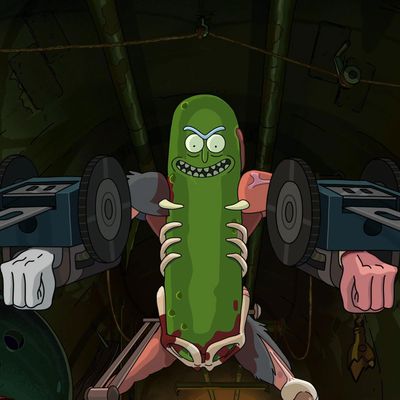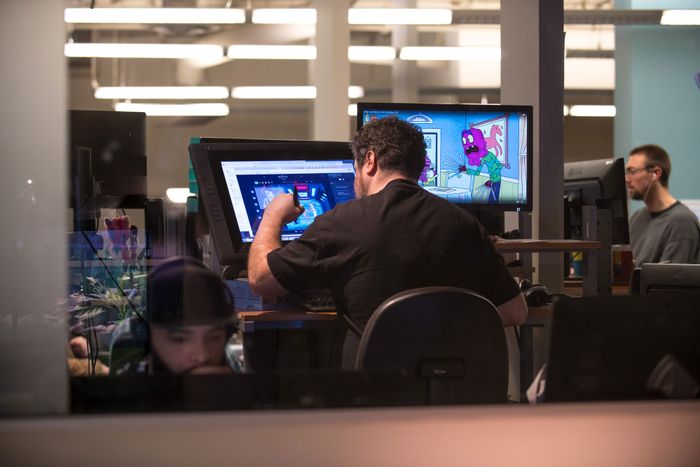
On a recent episode of Adult Swim’s popular animated sci-fi comedy Rick and Morty, a nefarious robot programmed by mad scientist Rick Sanchez using an algorithm derived from the plots of heist movies orbits an alien planet in a spaceship half the planet’s size, disguised as a construction worker. In a bid to “case” the planet the way a con artist might scope out a big score, the robot drops a comically oversize hidden camera on the planet’s surface, leveling a city and killing tens of thousands. As the planet’s bewildered alien residents scramble in terror, the robot transforms into a pizza guy, and blithely proceeds to deliver a continent-size pie. The pizza turns into an enormous drill; the drill digs to the centre of the planet; the robot makes off with the planet’s core, as the planet itself collapses. “I think we got away with it,” declares the robot, fleeing as pieces of the broken world float around it.
This entire sequence spans about 60 seconds, beginning to end. In addition to the transforming spaceship, the heist-loving robot, the camera, the pizza, the drill, and the molten planetary core, the scene includes an alien news program, a collapsing beach, a tidal wave through a dying metropolis, a menagerie of terrified animals, a huge origami calling card left behind by the robot at the scene of the crime, and of course an entire alien species never seen before on the show, which has its own original and interesting features. The idea of an evil robot capable of heisting whole planets is so hilarious and absurd that it’s possible to spend this minute-long scene in a fit of outrageous laughter. But then it occurs to you that someone had to make all this — not simply dream it up, which is amazing enough, but actually animate this madness from scratch.
“I’m sort of fighting myself when I watch an episode,” Nathan Litz, animation director at Bardel Entertainment, told me recently from his studio’s headquarters in Vancouver, British Columbia. “You see all the great action go by and it looks fantastic. But you look at it and you think, That took four weeks to do, and it played out in one minute.”
Litz heads the team of nearly 50 artists and animators responsible for realizing the vision of Rick and Morty’s co-creators and showrunners Dan Harmon and Justin Roiland week after week. He knows better than anyone how much work goes into making it happen — and how swiftly Rick and Morty dispatches even its most elaborate flights of blockbuster fancy. “The people at home have a nice laugh and they enjoy it,” he says. “But you just don’t get the full feeling of how much effort goes into every episode by watching the 22 minutes fly by on the TV.”
Rick and Morty is one of the strangest and most consistently audacious comedies on television. A science-fiction extravaganza that routinely involves interdimensional travel, earth-invading aliens, and planet-hopping adventures, it follows the ludicrous exploits of the so-called smartest man in the universe, Rick Sanchez, and his hapless, plucky teenage grandson, Morty, as they pursue obscure quests, run afoul of galactic law, and otherwise riff on the conventions of mainstream genre fiction, such as the heist movie. One of the most appealing things about Rick and Morty — and what has endeared it so intensely to so many fans — is that whenever it introduces an intriguing concept, it goes on to explore its own limits, often pushing ideas to their logical extreme. But while that creates some wonderfully preposterous TV, such as a beloved episode in which Rick turns himself into a pickle, it makes things very, very hard for the people tasked with getting it done.
“If you work on a fire-rescue show, you’ve got fire and water and smoke to deal with,” Litz explains. “On Rick and Morty, you’ve got fire, water, smoke, lasers, ship trails, explosions, everything you can possibly think of. The overall scope of things is what makes it the challenge that it is.”
This is, Litz points out, basically the opposite of how every other TV show works, especially in animation. “I can’t even think of a direct comparable because every other show is concerned with keeping it as conservative as possible, in terms of character count, locations, and so on. Whereas this show, they love to send someone off to some other universe, and give them three seconds with 15 different scenes, different background angles, different characters. Obviously every different planet and dimension has to be populated by original and interesting characters. Everything’s as lively as possible.”
This attitude accounts for why Rick and Morty doesn’t look and feel like anything else out there right now. “TV is very time- and budget-conscious, and they just want to get the least amount onto the screen as possible while still telling a story and making it funny or dramatic,” Litz says. “On Rick and Morty it’s about making it the biggest spectacle that it can be — which takes an awful lot of work to bring to life.”
As Rick and Morty finishes the first half of its fourth season, it’s obvious that the series is getting more ambitious. Litz has seen the evolution firsthand. “It’s absolutely gotten a lot bigger,” he says. “The ambition of the writers and designers only seems to grow. On the one hand that’s fun to do. But it can be a real struggle to maintain the level of quality while still trying to get these episodes done on time.”
Interestingly, Bardel’s bread and butter as an animation studio has not been this kind of huge, ambitious adult content, but rather cartoons for little kids. It has been very successful over the last several years in the preschool and age 6-11 spaces, developing a slate of DreamWorks spinoffs for Netflix, including All Hail King Julien, Kung-Fu Panda: The Paws of Destiny, and VeggieTales in the City. Although Tina Chow, head of development at Bardel, is quick to emphasize that Bardel “can work in any genre,” Rick and Morty certainly stands out among the Bardel animation roster. Litz himself had never worked on animation for adults before he was brought on to develop Rick and Morty’s pilot episode, in 2012. He says that while he “knew how much work it was going to be, and how much of a problem that could become,” he loved the show right away, and was eager to be involved.
“It’s a big difference to work on a project that you really enjoy the final product, as opposed to when it’s just a job,” he says. “As an animator you can of course still take a lot of pleasure in doing a scene that looks good, but if that scene comes in the middle of a show that you don’t really enjoy, you don’t get the same level of satisfaction. Working on a show like Rick and Morty, that’s not only fun and entertaining but also high-profile, that everyone is watching, is extremely satisfying.”
Chow also credits the animation team’s appreciation of the series for the effort and passion they put in: “We have people giving more than 110 percent to work on Rick and Morty,” she says. “We have people approaching us just because they want to work on that. It’s great to hire big fans, because they’re going to give it their all.”
For Litz and the team, the enormous amount of labor that goes into the project pays off when it’s all done. “It’s always great when we finish an episode and get together and watch it with the team,” he says. “You can always hear everybody whooping when their scenes come up. They have so much pride for this show.”





